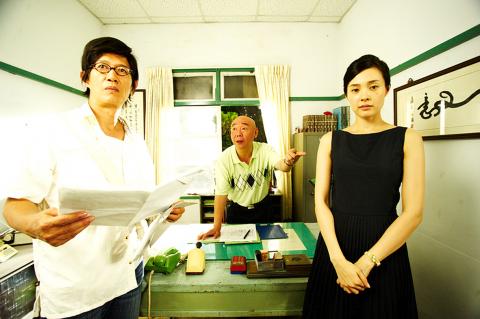Television cinematographer and director Lin Fu-ching (林福清) didn’t take the easy way out when it came to his debut feature Jumping Boy (不倒翁的奇幻旅程), a life-affirming children’s film that marries live action and animation. Though not the most exciting of movies, Jumping Boy deserves credit for combining real actors with animated elements while venturing into the territory of children’s cinema, a genre little visited by local filmmakers. Another merit is a lively cast led by eminent thespian Chin Shih-chieh (金士傑).
Chin plays Tian Bian, a celebrated children’s book author who rocketed to fame with his first published story, Roly-poly. But few people know that 20 years previously, the then-aspiring writer was repeatedly turned down by publishing houses and couldn’t sell any of the stories he wrote for his son, who was his most dedicated fan. One day, a friend of his son told Tian Bian a tale about a roly-poly doll. The writer took the story and passed it off as his own. Roly-poly became a best-selling book that brought Tian Bian fame and fortune, but the writer was never able to regain his son’s trust after the incident.
Back in the present day, Tian Bian decides to go back to his hometown in Tainan to find the boy he stole from and make amends. But instead of the boy, the aging writer meets Ka (Mai Hao-wei, 買皓瑋), an elementary school student who lost a leg to bone cancer. A friendship quickly develops between the two as they explore the pastoral town together and find strength in each other’s company along the way.

Photo courtesy of Activator Marketing Company
Director Lin reportedly invested three years and a personal bank loan worth NT$20 million in the work, which was inspired by a documentary he made in 2007 about a group of young children living with from bone cancer. Most of the movie takes place in the director’s hometown of Zuojhen (左鎮), Greater Tainan, where the mountainous, rugged landscape serves as a surreal backdrop for the film as it swings between reality and the fantasies told by Chin’s character.
Content-wise, the film is more about one man’s efforts to come to terms with his past than an imaginative portrait of the world as seen through the eyes of children. The story’s structure is a loose thread and risks losing the audience’s attention with its slow approach to storytelling. The already thin material is stretched even more in the middle of the movie.
The film’s five animated segments, totaling 25 minutes in length, are attention-grabbing. Beautifully realized by artist and professor Jack Shih (史明輝) and his team of student animators, each piece shows a distinctive style and can be appreciated as an individual work in its own right. Three of the five animated works have since entered the international film circuit and have been screened at showcases including the International Festival of Animated Films AniFest in the Czech Republic, Sapporo Short Film Festival in Japan and the International Short Film Festival Oberhausen in Germany.

Photo courtesy of Activator Marketing Company

Photo courtesy of Activator Marketing Company

The Directorate-General of Budget, Accounting and Statistics (DGBAS) told legislators last week that because the Chinese Nationalist Party (KMT) and Taiwan People’s Party (TPP) are continuing to block next year’s budget from passing, the nation could lose 1.5 percent of its GDP growth next year. According to the DGBAS report, officials presented to the legislature, the 2026 budget proposal includes NT$299.2 billion in funding for new projects and funding increases for various government functions. This funding only becomes available when the legislature approves it. The DGBAS estimates that every NT$10 billion in government money not spent shaves 0.05 percent off

It is a soulful folk song, filled with feeling and history: A love-stricken young man tells God about his hopes and dreams of happiness. Generations of Uighurs, the Turkic ethnic minority in China’s Xinjiang region, have played it at parties and weddings. But today, if they download it, play it or share it online, they risk ending up in prison. Besh pede, a popular Uighur folk ballad, is among dozens of Uighur-language songs that have been deemed “problematic” by Xinjiang authorities, according to a recording of a meeting held by police and other local officials in the historic city of Kashgar in

Dec. 29 to Jan. 4 Like the Taoist Baode Temple (保德宮) featured in last week’s column, there’s little at first glance to suggest that Taipei’s Independence Presbyterian Church in Xinbeitou (自立長老會新北投教會) has Indigenous roots. One hint is a small sign on the facade reading “Ketagalan Presbyterian Mission Association” — Ketagalan being an collective term for the Pingpu (plains Indigenous) groups who once inhabited much of northern Taiwan. Inside, a display on the back wall introduces the congregation’s founder Pan Shui-tu (潘水土), a member of the Pingpu settlement of Kipatauw, and provides information about the Ketagalan and their early involvement with Christianity. Most

The People’s Republic of China (PRC) was out in force in the Taiwan Strait this week, threatening Taiwan with live-fire exercises, aircraft incursions and tedious claims to ownership. The reaction to the PRC’s blockade and decapitation strike exercises offer numerous lessons, if only we are willing to be taught. Reading the commentary on PRC behavior is like reading Bible interpretation across a range of Christian denominations: the text is recast to mean what the interpreter wants it to mean. Many PRC believers contended that the drills, obviously scheduled in advance, were aimed at the recent arms offer to Taiwan by the